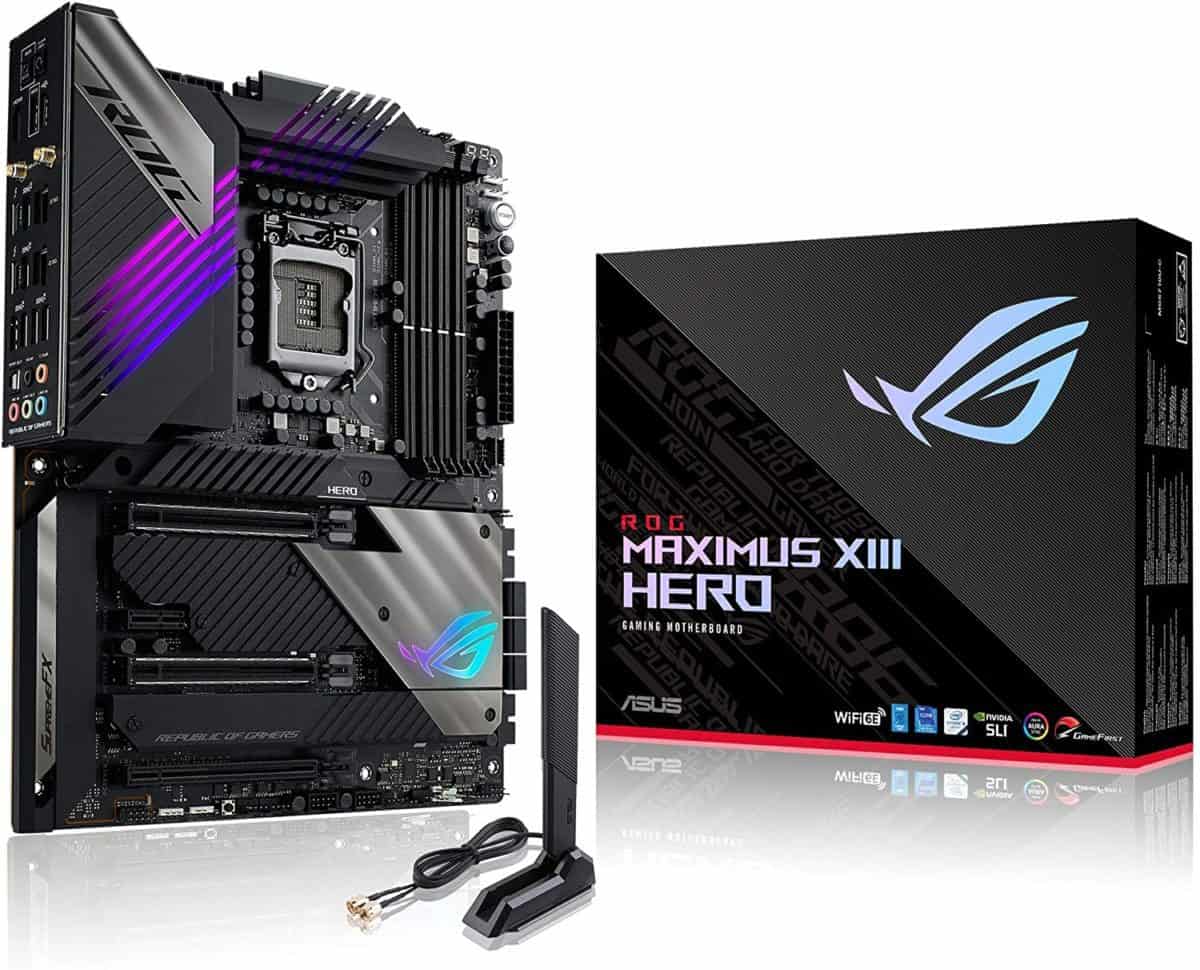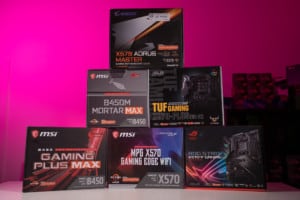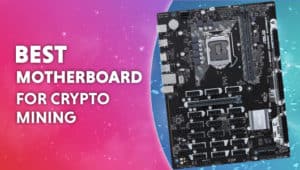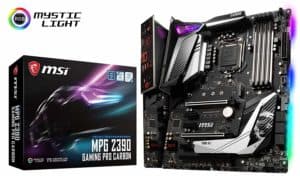Best motherboard for gaming in 2024: reviews and buying guide
We Help You Find The Best Gaming Motherboards For Your Needs

WePC is reader-supported. When you buy through links on our site, we may earn an affiliate commission. Prices subject to change. Learn more
For anyone looking to build a new gaming PC, finding the best gaming motherboard is a crucial, often overlooked step. You could already have a gaming rig setup but want to take advantage of a new Gen CPU and need one of the latest motherboards to go with it. Here are the best motherboards for gaming. You may stumble across this page and be unsure how to navigate through a motherboard correctly as it may come across as a tricky obstacle to hurdle! especially when choosing one of your CPUs but we’ve got you covered.
Sit back and read through our article, and by the end, you’ll be ordering the best motherboard for your needs. If you are still a little unsure as to what may be compatible with what, then you can check all of your components are compatible with each other if you need to. If you want a closer look at motherboards in general, then our motherboard parts explained page is for you!
Today’s best motherboard deals
- Micro Center CPU Motherboard Kit AMD Ryzen 7 7800X3D with ASUS ROG Strix B650-A Gaming WiFi 6E AM5 (LGA1718) – Save 9% now!
- MSI PRO Z790-A MAX WiFi ProSeries Motherboard – Save 8% NOW!
- Gigabyte B550 Gaming X V2 Gaming Motherboard – Save 28% NOW!
- INLAND Micro Center AMD Ryzen 5 5600X with MSI MPG B550 – Save 7% now!
- Micro Center AMD Ryzen 5 4600G with MSI B550 – Save 16% now!
- Micro Center AMD Ryzen 5 5600X with MSI B550M PRO-VDH – Save 7% now!
- ASUS TUF Gaming Z790-Plus WiFi LGA 1700(Intel®12th&13th Gen) ATX Motherboard – Save 18% NOW!
- Micro Center Intel Core i7-13700K and ASUS Prime Z790-P – Save 10% now!
- Micro Center Core i7-12700K and ASUS Z690 – Save 12% now!
- Micro Center AMD Ryzen 7 7700X and MSI PRO B650-P – Save 10% now!
Best motherboard for gaming 2024
Here we will list the best motherboards for gaming in 2024. This includes picks from all over the spectrum, incorporating both high-end enthusiast options and budget options.
ASUS ROG Maximus Z790 HERO
ASUS ROG Maximus Z790 Hero
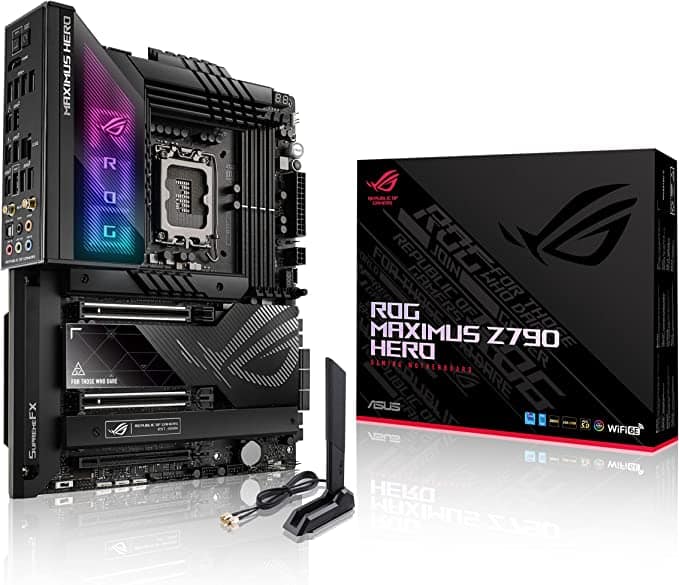
Form factor
ATX
Power stages
20+1 phase
Connectivity
2.5Gb LAN, WiFi 6E, Bluetooth 5, audio, USB4, USB-C, DisplayPort, Thunderbolt 4
PCIe Gen 5
GPU x16 and M.2
DDR5
Yes
- 24+1 phase VRM design
- 10 GbE LAN port
- 5 M.2 slots
- DDR5
- PCIe Gen 5
- Expensive
ASUS’ Maximus motherboard lineup has always been a favorite among enthusiasts and that remains true with the Z790 series. The ASUS ROG Maximus Z790 HERO is a top-tier motherboard that boasts impressive features and a powerful delivery system.
The VRM design of the Z790 HERO is very robust with a 24+1 phase VRM and 105A power stages, all beneath large VRM heatsinks. In essence, this motherboard can handle even the most challenging 13th Gen Intel Raptor Lake CPUs, even when overclocked.
Apart from the sturdy design, the Maximus Z790 HERO comes packed with premium features. It includes a 10 GbE LAN port and WiFi 6E to fulfill all your networking needs, and storage is handled by five M.2 slots as well as numerous SATA ports. Additionally, the board features two Thunderbolt 4 ports on the rear I/O, which is a nice addition.
Regarding aesthetics, the board is designed with gamers in mind as it displays the characteristic ROG design language. The pixelated ROG script on the I/O cover looks particularly attractive when installed in a chassis.
Overall, the ROG Maximus Z790 HERO is a remarkable motherboard with very few weaknesses. The only significant concern is its price, which is relatively high compared to the other alternatives available on the market.
ROG Crosshair X670E Extreme
ASUS ROG Crosshair X670E Extreme

Form factor
EATX
Power stages
20 + 2
Connectivity
2x USB4 ports, 10GbE Ethernet, advanced audio system, and Wi-Fi 6E adapters.
PCIe Gen 5
M.2 & PCIe x16 slot
DDR5
Yes
- Sleek design
- Efficient power stages
- Tonnes of connectivity
- DDR5
- Expensive
The Crosshair X670E extreme is a feat of engineering in its own right, it’s probably the highest-end AM5 motherboard you can own, next to GIGABYTE and MSI.
We know that the Asus X670E ROG Crosshair Extreme features VRMs based on Infineon ASP2205 power management IC (PMIC) and Vishay SIC850 110A smart power stages. Also, the Crosshair Extreme will feature a 20 + 2-stage power delivery system.
The Crosshair obviously ships on the DDR5 RAM standard, out with the old and in with the new DDR5 memory technology.
You can expect PCIe Gen 5 support on its 16x slot and PCI Gen 5 support for compatible M.2 drives too. Making for ultra-fast storage and almost real-time GPU communication times.
The Crosshair Extreme features future-proof connectivity, featuring two state-of-the-art USB4 ports, 10GbE Ethernet, a more advanced audio system, and Wi-Fi 6E adapters. All of these features make for one exciting Asus ROG motherboard.
ROG MAXIMUS Z790 EXTREME
ROG MAXIMUS Z790 EXTREME
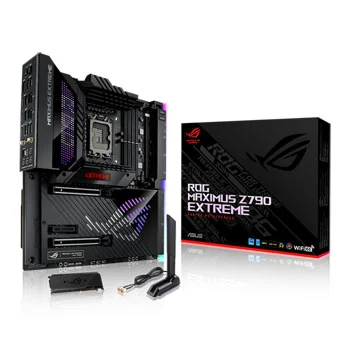
Form Factor
E-ATX
Power stages
24+1
Connectivity
USB 3.2 Gen 2×2 Type-C and front-panel connector with Quick Charge 4+ up to 60W, eight USB 3.2 Gen 2, and two PCIe 5.0 x16 SafeSlots
PCIe Gen 5
Yes
DDR5
Yes
- Strong power stages
- PCIe Gen 5
- Heightened DDR5 speeds
- Lots of connectivity
- Very expensive
The Maximus Extreme features a 24 + 1 power stage setup with dual ProCool II power connectors and premium metallic capacitors. Designed to take overclocking to the next level.
We have PCIe Gen 5 support on a single M.2 SSD slot and both of the PCIe X16 slots, bringing greater speeds to the likes of GPUs and NVMe SSDs respectively.
The Maximus is equipped with DDR5 support up to 7600MHz, making the Maximus one of the best motherboards for DDR5 too.
The Maximus is also teeming with connectivity, here are some of the connectivity you can expect to find on the Z790 Extreme: Thunderbolt 4 USB Type-C and front-panel connector, USB 3.2 Gen 2×2 Type-C and front-panel connector with Quick Charge 4+ up to 60W, eight USB 3.2 Gen 2, and two PCIe 5.0 x16 slots.
ASUS ROG Maximus Hero Z690 WiFi
ASUS ROG Maximus Z690 Hero WiFi
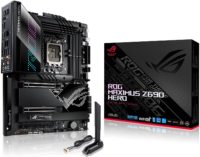
Form Factor
ATX
Socket
LGA 1700
Chipset
Z690
DDR5?
Yes
- 6400+ (OC) MHz max memory speed
- 4X 32GB DDR55 DIMM slots (128GB total)
- 20+1 power stages (90A)
- Great for overclocking
- Less power stages than the most premium models
- Very expensive
The ASUS ROG Maximus Z690 is a fantastic premium motherboard and the best Z690 you will find. This latest iteration features everything you need to get the best out of your Intel 12th Gen Alder Lake CPU.
If you’ve no interest in buying a 12th Gen CPU then we’d probably recommend going for a Z590 instead, but the Z690 offers maximum future-proofing.
Equally, if you’re looking to pick up a lower-end Intel CPU this board probably isn’t worth your money either, as you wouldn’t make the most out of the features available here which are geared (and priced) with high-performance users in mind.
The ASUS ROG Maximus Z690 board comes with an LGA 1700 socket as befitting an Alder Lake-compatible motherboard. As far as motherboards go it has a fairly striking look, between the integrated aluminum I/O cover and Aura Sync RGB lighting system.
The board comes with all the features you’d want for a high-performance, premium board with a robust power solution of 20+1 power stages rated for 90 Amps and a sizable VRM heatsink, not to mention ASUS’ Intelligent Control technology (essentially AI overclocking) and ROG water cooling zone.
Ports include PCIe 5.0, PCIe 4.0, Dual Thunderbolt 4 USB-C, as well as a ROG Hyper M.2 card with Gen 5 M.2 support. Although we would have liked to have seen 10GB Ethernet support in a motherboard of this price range, the 2.5GB will do for most users.
ROG Maximus XIII Hero Z590
ROG Maximus XIII Hero Z590

Intended Build
High-end
Form Factor
ATX
Socket
LGA 1200
Chipset
Z590
- 5-way optimization
- High performance networking
- Solid overclocking potential
- Can get quite hot
The Asus ROG Crosshairseries has been quite popular over the years, and this X570 chipset is likely to follow suit. This board comes after the anticipated release of the new Ryzen chips with provision for PCI-e 4.0 and lightning-quick storage. The Hero overall is an excellent board with few weaknesses to differentiate it from the rest.
The design appears to be similar to the Formula motherboard as the base without the display and excessive VRM water block. The motherboard is incredibly aesthetically pleasing as you would expect from the ROG department. The large heatsink features an RGB ROG logo, as does the I/O shroud, making the motherboard pop visually.
It is worth noting that this particular board only supports 2nd and 3rd Gen Ryzen CPUs. Despite being an AM4 socket, it doesn’t work with the 1st Gen Ryzens, and if you plan on taking advantage of the PCIe 4.0 functionality, then you are going to need to pair this with a 3rd Gen Ryzen chip.
We see 2.5G LAN support along with Intels WIFI 6. You also get a Type-C USB port, a BIOS flashback button, and a clear CMOS button to take away some of the overclocking headaches RAM can bring.
Overall the Asus ROG Crosshair VIII Hero is packed with features and performs as well as some of the best. This board and its plethora of USB ports is an excellent board and a fantastic alternative to the Godlike for performance and financial reasons. The layout of This motherboard is great, the RGB is catchy, and it’s better than its predecessor.
MSI B450 Gaming Plus MAX
MSI B450 Gaming Plus MAX

Intended build
Budget build
Form factor
ATX
Overclocking support
Yes
Socket
AM4
Chipset
B450
- Excellent build quality
- Overclocking capabilities
- Good value
- Only 802.11 AC WiFi
- one NVME
The MSI B450 Gaming Plus MAX is officially the cheapest budget range board on our list, however, don’t be totally fooled by the price tag. MSI has had to make some compromises to achieve the low price range but they have kept the core features gamers are most concerned about.
With 64GB of 4,133MHz RAM supported, this board is perfect for an AMD Ryzen build. Having said that, you can still make use of the excellent features to pair this board with any of the Ryzen 3rd gen CPUs. You won’t even have to update the BIOS either.
MAX means this board is already updated to the latest BIOS so you can simply pop your new chip into this motherboard without the fear of a none boot.
Unfortunately, the Gaming Plus only comes with 1 M.2 slot meaning future expansion is going to be fairly difficult if you’re looking at using multiple M.2’s. It’s easy to let them off though seeing as though it comes to shelves at such an affordable price.
One of our favorite boards here at WePC that’s great for anyone looking to build a decent first-time gaming rig.
Best budget motherboard for gaming
There are a few types of motherboards to choose from, if you’re on a tight budget, you’re sometimes better off looking for the last generation of technology to save a buck or two. This isn’t always possible, however, as in the case of the Ryzen 7000 series, there’s only one motherboard generation currently.
Wherever possible, you’re going to want to pick up an Asus Prime motherboard, take this for example:
ASUS Prime Z690-P
ASUS Prime Z690-P
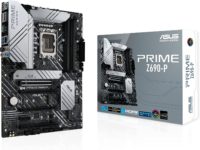
Form Factor
ATX
Socket
LGA 1700
Chipset
Z690
DDR5?
Yes
- 10+1 power stages
- 2x Thunderbolt 4 USB Type-C
- Less power and features than ATX models similarly priced
The ASUS Prime Z690-P is the best budget option on the list for a DDR5-compatible motherboard, with its supported speeds limited to 6000Mhz. However, it is an updated version of one of the most dependable boards on the market.
With support for DDR5, PCIe 5.0, and Thunderbolt 4, this motherboard offers a high-quality experience that won’t disappoint. The board also boasts impressive features such as 14+1 power stages, Wifi 6, and 2.5Gb Ethernet, making it an excellent value compared to some of the more expensive boards listed.
This is the 12th generation variant of the ASUS Prime, although it’s a great choice for 13th gen users looking to save a buck on the motherboard choice.
All ASUS prime motherboards are teeming with features, and offer an impressive level of connectivity for the price.
What to look for in a good gaming motherboard
When looking for a good gaming motherboard, there are several factors to consider. Here are some of the most important ones:
- Socket compatibility: Check if the motherboard supports the CPU socket type you have or plan to purchase. Intel and AMD have different socket types, so you need to make sure the motherboard matches your CPU.
- Chipset: The chipset is responsible for connecting all the components on your motherboard. Make sure the chipset is compatible with your CPU and supports the features you need, such as overclocking.
- VRM: The voltage regulator module (VRM) is responsible for delivering power to the CPU. A good VRM with high-quality components will provide a stable and efficient power supply to your CPU, which is important for overclocking.
- RAM compatibility: Check the motherboard’s RAM compatibility and the number of slots available. Ensure it supports the speed and capacity of RAM you plan to use, and has enough slots for future upgrades.
- Expansion slots: Determine what additional components you might want to add in the future, such as graphics cards or network cards, and ensure the motherboard has enough expansion slots to support them.
- I/O ports: Look for a motherboard with a good selection of input/output (I/O) ports, including USB 3.0 or higher, audio jacks, Ethernet, and HDMI or DisplayPort for video output.
- Cooling: Ensure the motherboard has sufficient cooling options, including fan headers and heatsinks, to keep your components running cool during intense gaming sessions.
By considering these factors, you can choose a gaming motherboard that meets your needs and provides a solid foundation for a high-performance gaming PC.
Best motherboard for gaming: Things to Consider
Now that you’re aware of the best options available to you, you’re going to have to choose a gaming motherboard that best suits you and your needs.
If you’re asking yourself, ”What motherboard should I get?” we’d like to make sure you know what makes a good gaming motherboard because there are a lot of factors to consider.
Here at WePC, we believe an educated consumer is an empowered consumer!
Form Factor

The physical footprint may be something you need to consider when choosing your motherboard. If you’re tight on space, you may want to consider a smaller-sized ITX computer case.
If you’ve got plenty of room and want to build an impressive system, then going for a larger form factor could be beneficial.
Whatever your case may be, there are several main types of form factors that motherboards come in. Including mini-ITX motherboards, micro ATX, ATX board, or E-ATX motherboard.
Socket
Every motherboard is going to have a specific socket type. This is the physical slot on the motherboard that holds your CPU in place. You’re going to have to match up the socket type of your motherboard to your CPU making sure they are compatible.
Trying to fit the wrong processor into the wrong socket type can cause fatal damage to your components, and no one wants that.
To make sure your CPU and motherboard are compatible, check the specs.
Chipsets
A large factor when determining which motherboard is right for you and your needs is the chipset. Your chipset is a key factor in determining which features your motherboard comes with.
This ranges from PCIe lanes to SATA ports, and even overclocking support. Even if your processor allows overclocking, if the motherboard’s chipset doesn’t support it, then you won’t be able to do it.
With AMD & Intel having non-compatible sockets and chipsets, it’s always worth making sure that your latest hardware components are compatible. Especially when new RAM, motherboards, and CPUs are being released on an all too regular basis.
Let’s take a look at some chipsets from both Intel and AMD. So you can find the best AMD motherboards, or the best choice of Intel ones depending on your preferred platform.
Intel
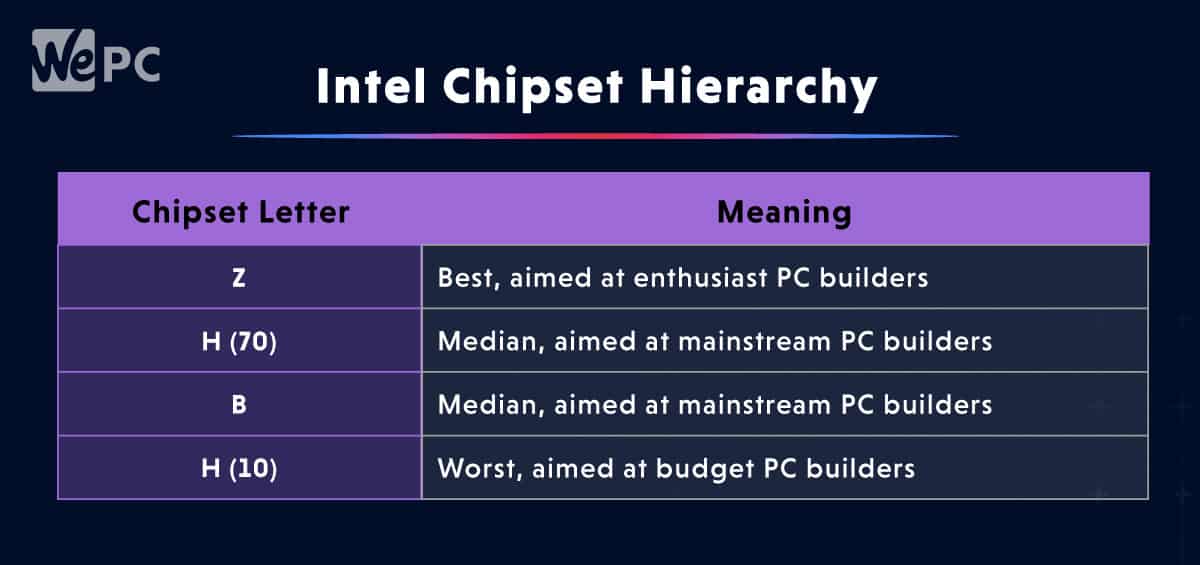
AMD

Memory
When it comes to checking memory compatibility, you need to pay attention to four things: Max supported memory, memory speed, multi-channel support, and how many memory slots are on the board.
Check the specs against the motherboard, this will let you know precisely what the motherboard will support when it comes to speed and how many memory slots there are.
Memory Location
Also, some motherboards will have their memory slots a little closer to the CPU than others. Once in a while, this can cause an issue with the CPU heatsink.
If you have a larger-than-normal heatsink for your CPU, you might want to make sure it won’t barge into your memory slot area.
PCI slots
Peripheral Component Interconnect, or PCI, is the physical slot in which you can expand the capabilities of your basic system.
This includes, but is not limited to things like:
Wi-Fi card
Video card
Extra USB ports
NVMe expansion cards
There are two types of PCI slots: PCI and PCI Express (PCIe). The PCIe slot is a larger, faster version of the PCI slot.
Basic expansion cards such as a wifi adapter only require a much smaller PCI slot, while larger, more powerful cards such as your graphics card, require a larger and more powerful PCIe slot.
Making sure you have enough PCI slots for all of your components is important.
If you’re running multiple GPUs and want to add in say a network and a sound card or an NVMe expansion card, you might have to check to make sure your motherboard has enough slots to accommodate.
The other thing to look for is plenty of spacing. If you’re planning on running multiple GPUs that are large, you may need PCIe slots that are further apart to allow for adequate space.
Fan Headers
The last thing you need to make sure of is that you have enough fan headers for everything you plan on running.
If you’re running a lot of fans, or maybe RGB controllers, you’re going to have to make sure you have enough headers on the motherboard to support this.
If you’re interested in learning more about motherboards, then you can read all about how motherboards are made, as well as what all of the main components do.
Zen 4 CPUs
AMD’s Zen 4 CPUs require a brand new motherboard to function, they will not fit in your old AM4 motherboard, so you have very little choice in the way of saving money as you can with Intel. You HAVE to pick up a new motherboard.
Fortunately, AMD has built-in AM4 cooler compatibility, so that’s one thing you don’t have to upgrade at least.
Which Gaming Motherboard Is Best For You?
So, you know the motherboards available to you, but which one is the best fit for you? Let’s take a moment to talk about that.
High-end gaming motherboard
A high-end motherboard would be for someone who is either looking to push their gaming performance to the next level or needs something to help with their content creation.
The benefits of a high-end build include:
- More PCIe lane bandwidth, allowing for faster gaming and processing
- More expansion ports
- Better quality components to handle the increased usage
Mid-range gaming motherboard
Buying a mid-range motherboard would be a good investment for anyone who doesn’t need all the bells and whistles of a high-end board, but still wants solid performance out of their machine.
The benefits of a mid-range build include:
- More cost effective
- Smaller components meaning less space required.
- Large component availability since the vast majority are more budget focused.
Budget gaming motherboard
Those that are interested in budget motherboards are probably looking for something that will get them up and running without breaking the bank.
Ultimately, budget boards make compromises to accommodate such low prices. However, that’s not always a bad thing.
The two budget boards we’ve recommended are from reliable providers, and have plenty of room for add-ons, making them very versatile and good value for money.
Learn how to enable TPM 2.0 here.
Does the motherboard affect PC performance?
Motherboard choice has a significant impact on PC performance because it serves as the foundation and central hub of the system. The motherboard determines the type of CPU and memory that can be used, affects the speed of communication between components, and governs the system’s power management and overclocking abilities.
The number and type of expansion slots, ports, and storage options provided by the motherboard also have an impact on overall performance and functionality. A high-quality motherboard can help ensure that the components in a PC work together effectively and deliver optimal performance, while a poorly chosen motherboard can limit the potential of even the best components and result in a system that’s unstable or unreliable.
The compatibility and stability of the motherboard can impact the performance and longevity of the entire system, so it’s important to choose a well-made, reliable motherboard that is appropriate for the specific needs of the system.
Should you choose a motherboard or CPU first?
It depends on your specific needs and budget. In general, it’s recommended to choose your CPU first, as this will determine the motherboard options available to you.
The CPU is the “brain” of your computer, and its specifications will determine the type of motherboard you need, such as the socket type, chipset, and supported RAM speeds. Once you’ve chosen your CPU, you can then look for a compatible motherboard that meets your needs in terms of features, price, and brand preference.
However, if you have specific requirements for your motherboard, such as a certain size or particular features, you may want to start with the motherboard selection and then choose a compatible CPU.
Best motherboard for gaming FAQs
Here are some of the most commonly asked questions about the best motherboards for gaming.
Do I need an expensive motherboard for gaming?
You do not necessarily need an expensive motherboard for gaming, but it depends on your specific needs and requirements. A mid-range motherboard with decent features and compatibility can be enough for most gamers.
However, if you plan to use high-end components such as the latest processors, graphics cards, and fast RAM, you may need a more expensive motherboard that supports these components and provides better stability and performance.
Furthermore, if you are interested in overclocking your components to achieve higher performance, you may need a motherboard with advanced overclocking features, which can be more expensive.
In general, it’s essential to choose a motherboard that fits your needs and budget. If you’re on a tight budget, you can still find a decent motherboard that meets your gaming requirements without breaking the bank.
Can motherboards affect gaming performance?
The motherboard itself does not directly improve gaming performance, but it can indirectly affect gaming performance in a few ways.
First, the motherboard determines the compatibility and support for different components, such as the CPU, GPU, RAM, and storage devices. A motherboard that supports faster processors, more powerful graphics cards, and higher-speed RAM can result in better gaming performance.
Second, the motherboard can affect the stability and reliability of the system, which can impact gaming performance. A high-quality motherboard with better power delivery, cooling, and other features can ensure that the system runs smoothly and without crashes or other issues, which can improve gaming performance.
Finally, some motherboards come with additional features that can enhance gaming performance, such as built-in sound cards, network controllers, and overclocking tools. These features can improve the overall gaming experience and potentially boost performance.
Can you overclock all motherboards?
Most modern motherboards have some level of support for overclocking, but not all motherboards are created equal. Some motherboards may have more advanced features and better power delivery systems that make them better suited for overclocking.
On the other hand, some budget or entry-level motherboards may not have as much support for overclocking or may not be capable of handling the increased power demands of overclocking.
It’s important to research and chooses a motherboard that is capable of supporting the level of overclocking you want to achieve. Additionally, it’s important to note that overclocking can void your warranty and potentially damage your hardware if not done properly, so it’s recommended to proceed with caution and follow appropriate safety precautions.
Final Word
You’re in good hands with every motherboard here. We like to think that we made the right choices here, but if you have any other suggestions please don’t hesitate to let us know.
The motherboard is the most important part of your PC, and it’s best that you don’t scrimp on it, the motherboard ties everything together, it’s the very foundation of your PC as you know it. Don’t let your motherboard choice suffer just to save a few bucks.

